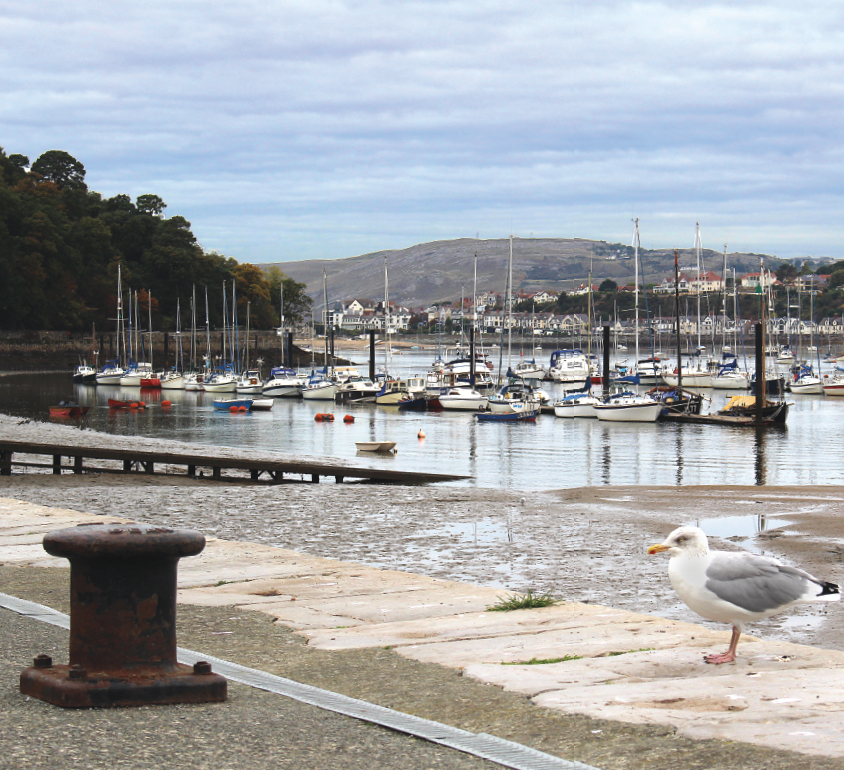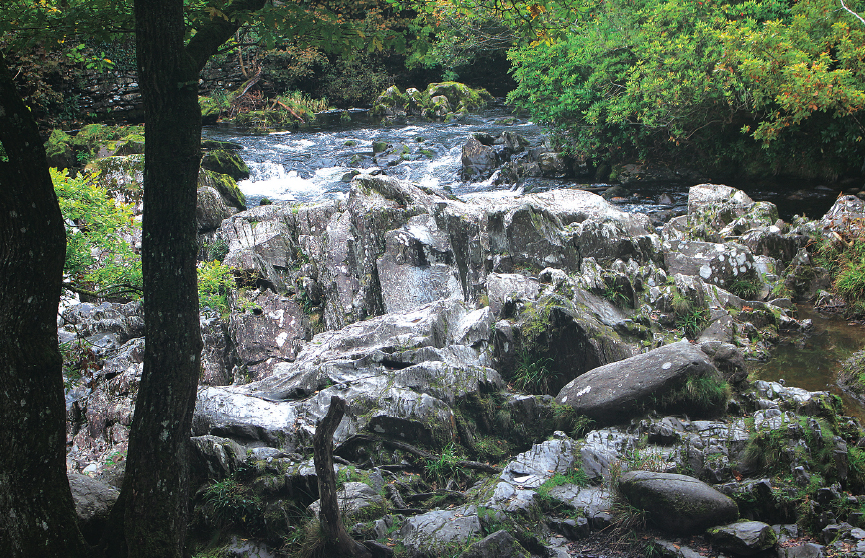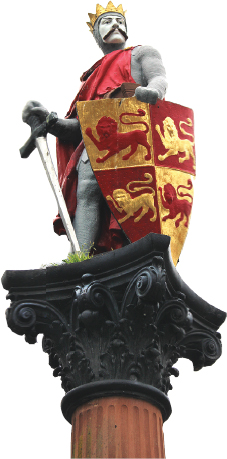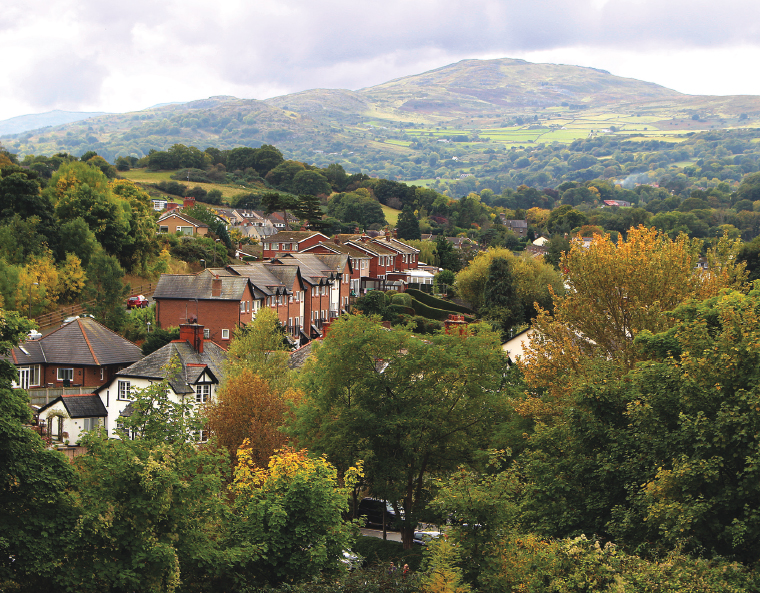
North Wales’ highlights gather along the beauteous Vale of Conwy

DANA HUNTLEY
[caption id="RiverConwy_img1" align="aligncenter" width="355"]

DANA HUNTLEY
By the time its primary stream and tributaries have gathered near Betws-y-Coed, the River Conwy flows north barely 20 miles before it broadens into an estuary south of Conwy and enters the Irish Sea. This is the pretty Vale of Conwy. It splits North Wales at its center, with Snowdonia’s wild mountains and lairs of Celtic princes to the West.
At a confluence of small rivers rolling into the Conwy, the village of Betws-y-Coed is a gateway into the mountains of Snowdonia National Park. Hotels and hostelries abound, and shops of outfitters equip hikers, bikers and campers preparing for outdoor adventures. The liveliest place in town is the old Royal Oak Hotel, complete with popular bar, informal bistro and a large beer terrace often echoing with live music.
Nearby, the river rushes through a woodland gorge known as Conwy Falls. Woodland walks thread along the way, and a fish ladder aids salmon and seatrout on their way upriver to spawn.
Betws-y-Coed’s popularity as a holiday base lies in its location as well as its forest setting. From the east, the A5 leads from Shropshire through Llangollen and continues west to Bangor and Anglesey. From the southwest, the A470 crosses the mountains from the coast through Blaenau Ffestiniog and a rugged countryside pocked with slate caverns and their slag heaps. The A470 leads north from Betws-y-Coed through the pretty river valley.
At Trefriw, cross the medieval arched bridge across the river to visit Trefriw Woolen Mills (featured in “How to Discover Textiles,” February, p. 28). Most famous for weaving traditional Welsh bedspreads, the mill also produces travel rugs and tweeds for caps, capes and jackets. Watch the looms and spindles in operation, and pick up a momento that will last a lifetime.
[caption id="RiverConwy_img2" align="aligncenter" width="865"]

DANA HUNTLEY

DANA HUNTLEY
Half a dozen miles north in Tal-y-Cafn, Bodnant Garden is for many the highlight of a River Conwy discovery. Among the most glorious and famous of Britain’s gardens, Bodnant is a jewel in the National Trust crown. Spreading across 80 acres of rising ground overlooking the river valley, terraced gardens and immaculate lawns of the upper garden slope gently toward the “Dell” and banks of wildflowers near the riverside. In spring, Bodnant’s magnificent, cascading, golden laburnum arch is a worthy destination in its own right.
As the Conwy broadens into its tidal estuary, the east bank becomes a RSPB (Royal Society for the Protection of Birds) nature reserve, sheltering abundant wildlife and proferring magnificent views of Snowdonia.
At Conwy, engineer Thomas Telford’s 1826 suspension bridge still stands across the Conwy, but through road traffic now crosses under river on the A55—the dual carriageway that carries through traffic across North Wales from Chester to Holyhead.
Dominating the town, and providing the reason for its existence, is Conwy Castle, first of King Edward I’s four fortresses built to subjugate the rowdy Welsh and their princes. Curtain walls leading from the castle surround the medieval town that sprang up in its shadows. Built in the 1280s, both castle and walls remain largely intact, complete with a trio of gateways.
Within the walls, Conwy’s ancient street plan includes Aberconwy House, a 14th-century merchant’s house in the care of the National Trust. Just down the High Street, visit Plas Mawr. Like Conwy Castle, fully restored by Cadw, Plas Mawr is regarded among the finest Elizabethan townhouses in Britain—colorful and well worth a visit. Shops, services and assorted cafes and pubs serve locals and the town’s many visitors. You may well hear Welsh spoken on the streets.
On the colorful quay, admission is one pound to visit the famous Smallest House in Wales. Boats tied up and moored in the estuary now are largely pleasure craft instead of working fishing boats. River Conwy mussels, however, are a highly prized delicacy that still thrive on the broad riverbed and are farmed commercially. A barge in the river provides a washing station for the dredged mollusks before they are brought to shore where they are available on the quay and shipped across the country.
To the east side of River Conwy’s estuary, Llandudno is North Wales’ largest and most popular seaside holiday resort (and deserves to be). Sitting on a neck, Llandudno has a beach on Conwy Bay and on the more commercial Colwyn Bay side as well. All the accouterments of the British seaside are present, including a classic pier jutting half a mile into the sea. Lewis Carroll composed Alice in Wonderland on holiday here. The town takes full advantage of the connection, with a trail of sculptures depicting the fantasy’s characters scattered through town.
Towering over Llandudno is the dramatic headland of Great Orme. Take a cable car from town to Great Orme’s summit. From there, dramatic views survey the River Conwy estuary to the west and Colwyn Bay to the right. A Bronze-age copper mine, the oldest in Europe, provides clear evidence of human occupation back 4,000 years. Overlooking the bay, tiny St. Tudno’s Church, dedicated to one of Wales’ oldest Celtic saints, remains an active parish as it has been for 1,400 years.
You can drive the length of the Vale of Conwy, with a few brief stops, in a couple of hours. Or you can spend two or three days along the River Conwy’s verdant path. Make a base in Betws-y-Coed for a day or two of exploring in Snowdonia, or in Conwy to ramble along the North Wales coast to the isle of Anglesey.
For a portfolio of pictures in the Vale of Conwy, visit britishheritage.com/river-conwy
ACCOMMODATIONS
While the Vale of Conwy offers plenteous accommodation across the spectrum of pocketbooks, here are several well-located, historic hotels of style and character to consider.
Royal Oak Hotel, Betws-y-Coed
www.royaloakhotel.net
Castle Hotel, High Street, Conwy
www.castlewales.co.uk
Dunoon Hotel, Llandudno
www.dunoonhotel.co.uk
[caption id="RiverConwy_img4" align="aligncenter" width="760"]

DANA HUNTLEY





Comments